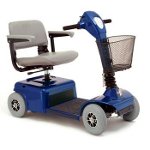The Wheelchair Guide
Your Wheelchair and Mobility Scooter Resource
A Look at Mobility Scooters and Their Uses
Monday, September 14th, 2009 at 10:01 am
 The mobility scooter has actually been around for almost fifty years, but it did not gain popularity until the end of the twentieth century. This was in part because the cost of mobility scooters was much greater until that point. Perhaps the Rascal Mobility Scooter is the most well known, which helped bring these devices to the publics conscious, but today, mobility scooters are more popular than ever.
The mobility scooter has actually been around for almost fifty years, but it did not gain popularity until the end of the twentieth century. This was in part because the cost of mobility scooters was much greater until that point. Perhaps the Rascal Mobility Scooter is the most well known, which helped bring these devices to the publics conscious, but today, mobility scooters are more popular than ever.
Mobility Scooter Design and Their Differences from Electric Wheelchairs
Mobility scooters are in many ways similar to electric wheelchairs, with many of the popular mobility scooter manufacturers, such as Pride Mobility Scooters and Golden Mobility Scooters, offering both types of devices. As a result, they share many of the same components and electrical systems, but the actual layout of a mobility scooter is much different from an electric wheelchair. It is this difference in design, which makes the purposes of electric wheelchairs and electric scooters much different.
The basic difference is that a mobility scooter has a much longer base, often more than 5 times as long as an electric wheelchair. The user is positioned towards the rear of the electric scooters base and a tiller, which is basically a set of handlebars, is installed on the front of the scooter. As a result of the longer base and the tiller, a mobility scooter is not something you could drive up directly to a table or desk as you would an electric wheelchair. Instead, it would be necessary to transfer to a chair or drive the scooter up parallel to the table, although the latter will often not allow the user to make full use of the table.
With the difference in design between electric wheelchairs and electric scooters comes a difference in target markets. Most of those who use mobility scooters are able to walk for short distances, but have difficulty walking for extended periods. This makes them very popular among seniors, who might not otherwise be able to fully use their home, go shopping, or spend time with their family. Some people who use wheelchairs, however, do enjoy using mobility scooters for outdoor use though, especially heavy duty mobility scooters, which can be driven pretty much anywhere.
With the similar functions of electric wheelchairs and mobility scooters, it begs the question, why don’t people just use electric wheelchairs. There are several answers to this, but cost is often a leading factor, as most mobility scooters cost considerably less than the average electric wheelchair. Mobility scooters are also often better suited for longer distances and rougher terrains.
Mobility Scooter Manufacturers
There are many electric scooter manufacturers, but those manufactured by Pride Mobility and Golden Technologies are the most common, with both of these companies having been involved in the mobility vehicle industry since the early nineties. There are a number of lesser manufacturers as well, but the quality of Pride Mobility Scooters and Golden Mobility Scooters is well known and respected. These companies both also offer comprehensive warranties on their scooters.
ShopRider is another popular company, although they lean more towards the budget end of the spectrum and are often not as durable as Pride Scooters and Golden Scooters. Drive Medical is another mobility scooter manufacturer, who is most well known for their manual wheelchairs, although they also offer a number of other medical devices.
There are also a number of no-name mobility scooters available, often from manufacturers in China. These usually cost a great deal less, but are not made to the same high standards as the well known mobility scooter manufactures, are prone to failure, and are usually not covered by a very comprehensive warranty.